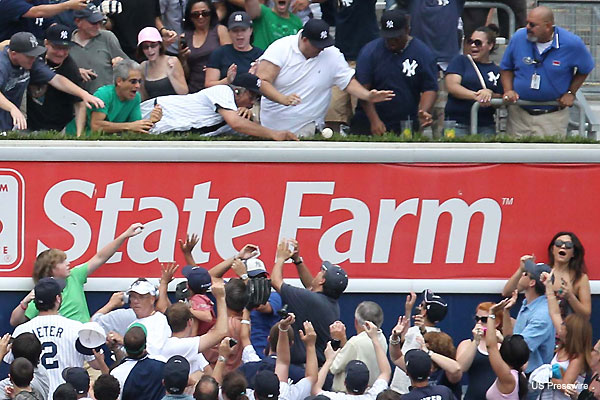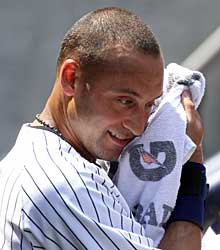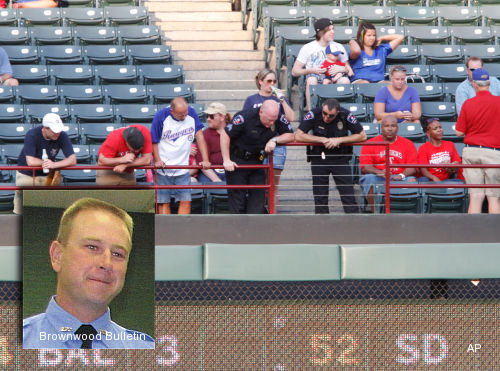 To my friends who are Red Socks fans..Thinking of you all today.
To my friends who are Red Socks fans..Thinking of you all today.
Now there are six.
The greatest New York Yankees have long been counted on one hand. Babe Ruth is the unquestioned No. 1, after which the order is debatable but not the names: alphabetically, Yogi Berra, Joe DiMaggio, Lou Gehrig and Mickey Mantle.
Add Derek Jeter to the mix.
Jeter became the first Yankee to accumulate 3,000 hits in pinstripes when he hit a solo home run off Tampa Bay lefty David Price in the third inning Saturday in the Bronx. Jeter, who just returned after spending three weeks on the disabled list with a calf injury, singled in the first inning for No. 2,999. In his next at-bat, Jeter ripped a full-count slider from Price into the leftfield seats. And despite the recent cyber-trend to disparage Jeter's game and accomplishments, he deserves mention alongside the best to play for baseball's most storied franchise.
Precisely where does he rank? From a poetic standpoint, No. 2 would be the perfect perch. Cue a tape of Bob Sheppard to make the announcement:
"The shortstop, number 2, Derek Jeter, number 2."
But that's a difficult case to make. To eclipse every Yankee except Ruth, Jeter would need to bounce back offensively through 2013. He'd need to change positions so his deficient range at shortstop recedes into memory. And the Yankees would need to win two more World Series with Jeter a driving force through those postseasons.
Today, though, Jeter has gained entry into the land of the elite. A Fab Five is now a Sparkling Six.
Here's our list, in reverse order. Class, grace and a certain "Yankee-ness" count. So do stats. Only accomplishments with the Yankees are considered.
It all adds up to "greatness," an admittedly imprecise blend of hard numbers and subjective notions. Cast your vote in ThePostGame.com poll.

6. Yogi Berra
Berra was part of a major league record 10 World Series champion teams, was named American League Most Valuable Player three times and played the most demanding position on the field. He also developed an iconic oracle-like persona with his fractured speech and hilarious yet astute observations. And at 86, he's not only the lone living member of the Sparkling Six besides Jeter, he still wears pinstripes. Berra anchored the team during its late-1940s and 1950s heyday, succeeding Hall-of-Famer Bill Dickey at catcher and playing alongside DiMaggio and Mantle. He has the fourth-highest Wins Above Replacement of any catcher in history.

5. Derek Jeter
Jeter's stature and leadership are unsurpassed. His production in the media hellfire of the Bronx has been phenomenally consistent. His five World Series titles and overall postseason excellence set him apart from other active players. In 2001, his flip of a relay throw to home plate and his walk-off home run in Game 4 of the World Series are among the most memorable moments in Yankees history. Of course he's slipping at 37: Mantle, DiMaggio and Gehrig were retired at that age. Yes, he's made more outs and hit into more double plays than any other Yankee and he'll probably pass Mantle for most strikeouts. One milestone begets others for the player with the most plate appearances, official at-bats, hits and stolen bases. Each category speaks to longevity, durability, toughness and resilience.

4. Mickey Mantle
Like DiMaggio, Mantle retired at age 36. Like Jeter, his defensive skills eroded with age and -- in Mantle's case -- injury. But like Berra, Mantle played 18 Yankee seasons because he broke in at age 19. He and Willie Mays vied for the title of best player on the planet through the 1950s and much of the '60s. The switch-hitting Mantle was AL MVP three times and he led the Yankees to 12 World Series, winning seven titles. He might have had more natural ability than any player ever, but he frittered away some of his talent partying. Who knows the numbers he could have amassed had he not been such a carouser? That question need never be asked of Jeter, who by remaining productive for two more seasons could swap places with Mantle.

3. Joe DiMaggio
The Yankee Clipper was the team's most majestic player, and only Gehrig and Jeter approach his stateliness. DiMaggio's greatest accomplishment is his record 56-game hitting streak. A close second is his nine World Series titles, behind only Berra in Yankee history. DiMaggio's offensive numbers across the board are exceptional per season, but his career totals are lacking because he retired after 13 seasons, at least four fewer than the others on the list, primarily because he missed three years serving in World War II. At age 35 in 1950 DiMaggio had a stellar season that mirrored his career numbers. A year later his performance declined because of nagging injuries and he hung 'em up after helping the Yankees to one more World Series championship.

2. Lou Gehrig
As he was in the Yankees lineup from 1925 to 1934, Gehrig is immediately behind Ruth on the list of Yankee Greats. When the measure is a blend of batting statistics, World Series titles, impact on baseball, impact on New York, larger-than-life persona and unforgettable nickname, The Iron Horse noses out the rest of the pack. Gehrig's greatness was perhaps best displayed after Ruth left the Yankees. Gehrig led the team to three more World Series titles for a total of six, and he batted .361 with a staggering 1.208 OPS in the postseason. His career was tragically cut short at 36 after 17 seasons because of the rare disease that bears his name.

1. Babe Ruth
Besides singlehandedly introducing home run power as the game's most lethal weapon and gate attraction, Ruth also made the Yankees the greatest team in baseball. Before his arrival in New York in 1920, the franchise had a losing record. In Ruth's 15 seasons with the Yankees, and for the next 30 years beyond his departure, they had only one losing season. His career offensive Wins Above Replacement of 143 is easily the franchise best and he holds the trifecta of highest batting average (.349), on-base percentage (.484) and slugging percentage (.690). Ruth won fewer World Series titles with the Yankees (four) than any of the others on this list. But he delivered, hitting 15 homers in 117 at-bats. .



 "No, not really," Lopez said when Yankees announcer Michael Kay later asked him if he asked for anything in return. "He deserves this, he's worked hard for this ... I'm not the type of person to take this away from him."
"No, not really," Lopez said when Yankees announcer Michael Kay later asked him if he asked for anything in return. "He deserves this, he's worked hard for this ... I'm not the type of person to take this away from him."








